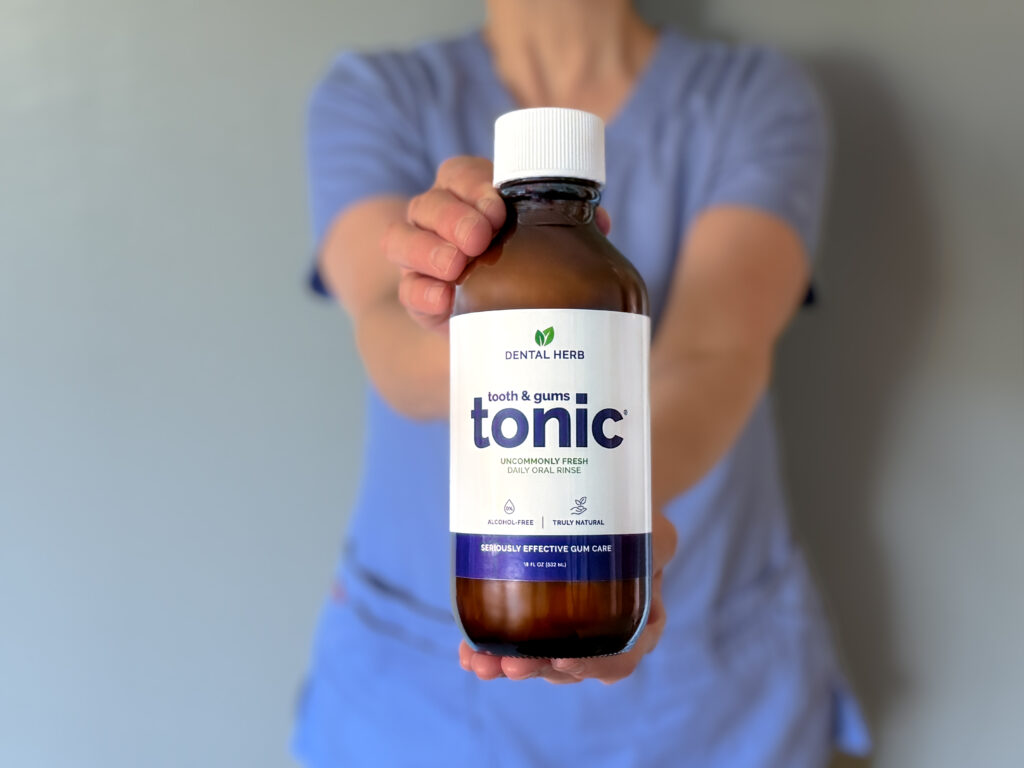Tooth & Gums Tonic® earns the Editor’s Choice Award and Clinical Problem Solvers Award
Truly Natural Ingredients with Clinically Proven Efficacy

Editor’s Choice
Award

Clinical Problem Solver
Award






A good alternative to chlorhexidine.
Reduces inflammation during pregnancy and it is safe to use.
Reduced halitosis in patients with dry mouth.
—Clinical evaluator comments, Dental Advisor
Tooth & Gums Tonic vs. Chlorhexidine
In a 12-week trial, the University of Rochester, Eastman Institute for Oral Health, compared the effects of Tooth & Gums Tonic and 0.12% chlorhexidine on gingival index (GI), plaque index (PI), pocket probing depth (PD) and reducing the levels of whole mouth and tongue malodor over a three month period.
The results of this study indicate that Tooth & Gums Tonic is as effective as chlorhexidine in reducing dental plaque, gingival inflammation and oral malodor. (Malmström, 2007)

Naturally Strong Oral Care
Additional Clinical Data
University of Rochester, Eastman Dental Center Studies:
Recent Articles:
- Cherise McCrea, RDH, Essential Oils in Dentistry, Dentistry Today, Winter 2022
- Kim Miller, RDH, The Trend Toward Natural Products, RDH Magazine, April 2013
- Dr. Michael DiTolla, DDS, FAGD, Dr. DiTolla’s Clinical Tips, Chairside Magazine
- Dr. Michael DiTolla, DDS, FAGD talks about the success of Tooth & Gums Tonic
Clinician’s Report (previously CRA):
- Fresh Breath Study, May 1999
- For copies of more recent reports, please contact us.
Dentistry Today studies:
- Dr. Ian E. Shuman, DDS, FAGD, The Gentle Art of Periodontal Maintenance: A Protocol Using Essential Oils
- Dr. Steven M. Parrett, DDS, Microbiologically Monitored Periodontal Therapy Using an Herbal and Essential Oil Irrigant
- Dr. Bernard Schechter, DDS, Time-Tested Botanical Remedies for Modern Periodontal Therapy
Related Articles:
- Dr. Joe Blaes, DDS, How to Profit from…Hygiene — Healthy Tissue Equals Great Restorative Dentistry!, Dental Economics
- Dr. Tom Orent, DMD, Academy Gems: It’s about Thyme, AACD Journal, Spring 1999
- Dr. Tom Orent, DMD, I Told My Periodontist: Keep Your Hands Out of My Pockets, The Independent Dentist Newsletter
- Gordon J. Christensen, DDS, MSD, PhD, Ask Dr. Christensen, Dental Economics, August 21, 2001
Research on the Impact of Essential Oils on Oral Health
Three herbal products including Tooth & Gums Tonic were found to be effective alternatives to chlorhexidine in the management of periodontal diseases.
Efficacy of cinnamon, red thyme and other essential oils in the treatment of biofilms.
When used as an adjunct to unsupervised oral hygiene, EO provides an additional benefit with regard to plaque and gingivitis reduction.
Cinnamon Oil is a natural anticandidal agent that can be effectively utilized for the control of the yeasts tested.
Analysis of the efficacy of essential oil and other rinses on periodontal health.
The results of the present study suggest that the adjunctive use of Essential Oils to a combination of subgingival ultrasonic instrumentation (SUI) and mouth rinsing is effective in reducing subgingival bacterial counts in both shallow and deep pockets.
In long-term use, the standardized formulation of essential oil mouthwash appeared to be a reliable alternative to chlorhexidine mouthwash with respect to parameters of gingival inflammation.
The mouthrinses tested showed different levels of biofilm penetration. The essential oil rinse was superior to other rinses by all three of the in vitro measurements performed.
Although less potent than the chlorhexidine gluconate rinse, the herbal rinse was more effective than the essential oil rinse in inhibiting the growth of oral bacteria in vitro.
